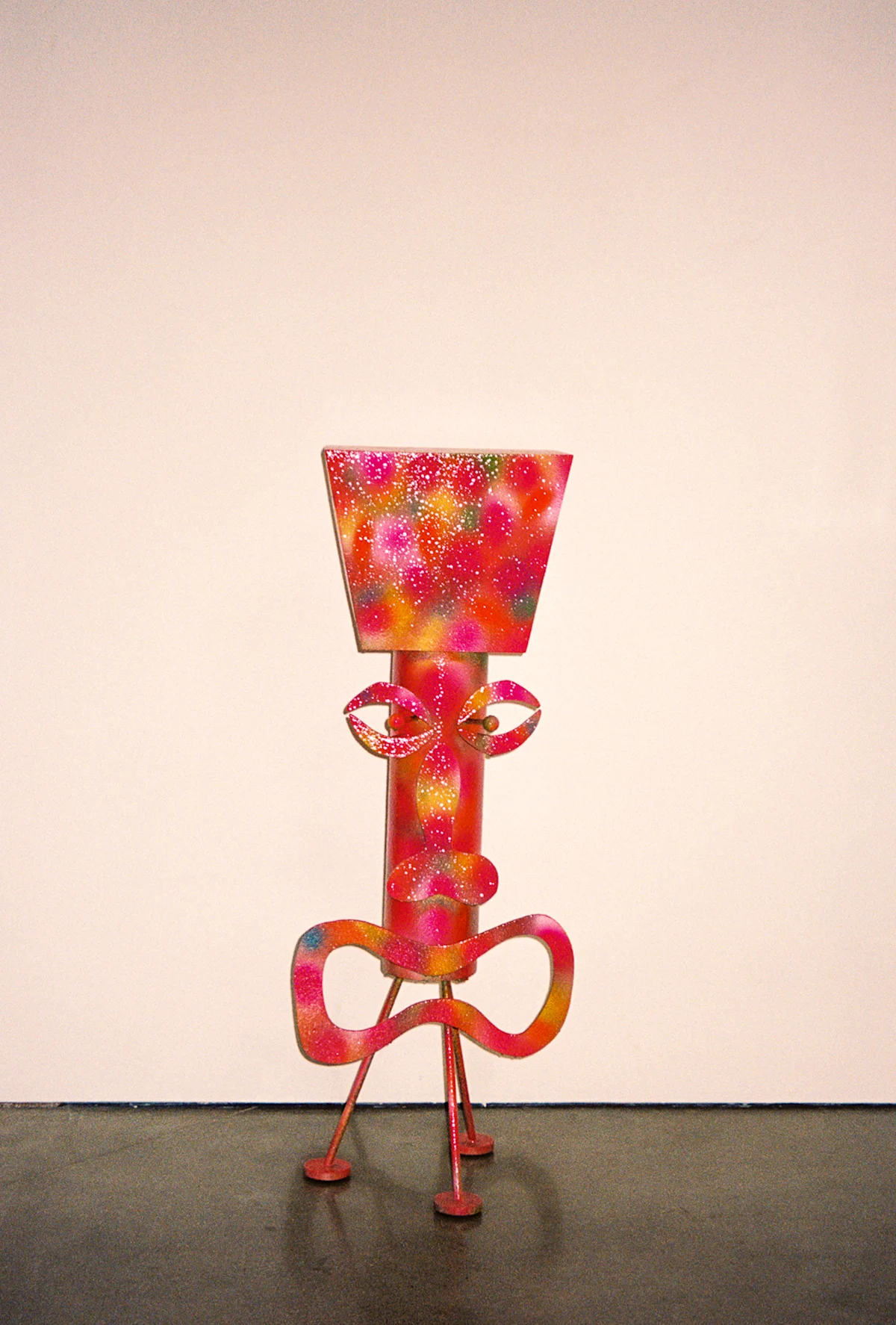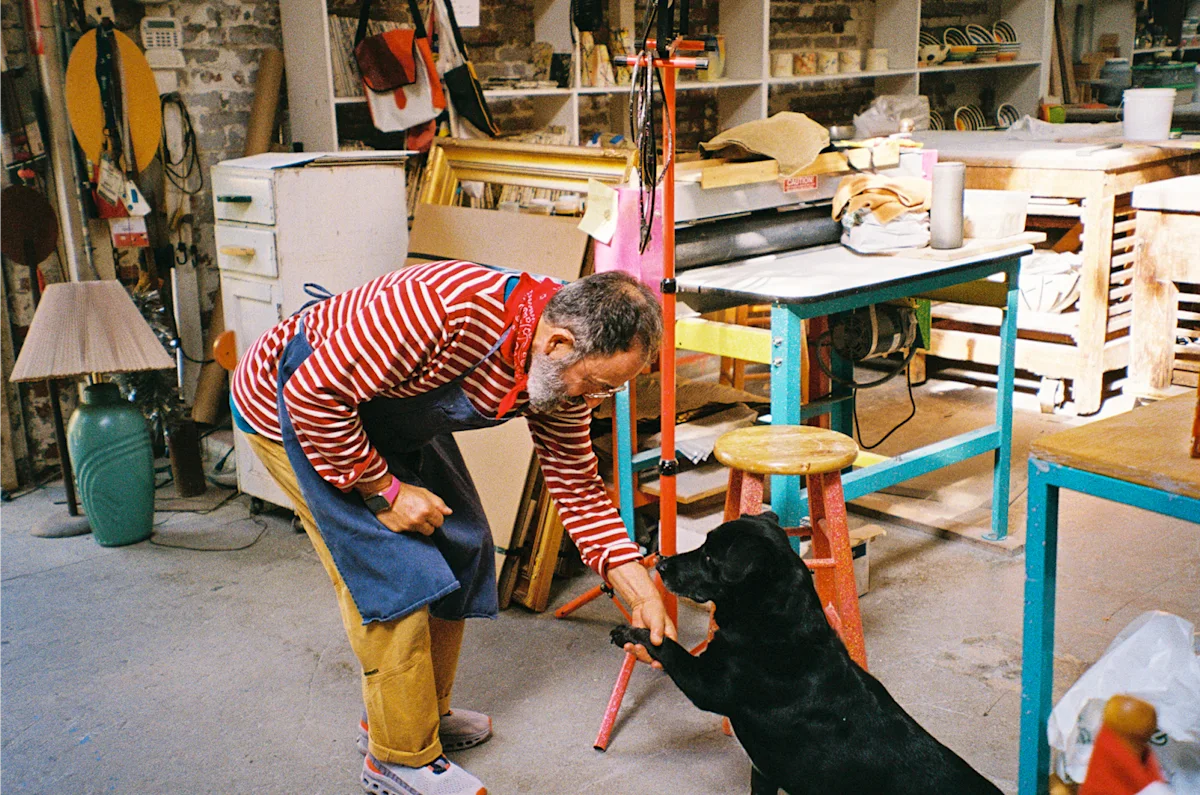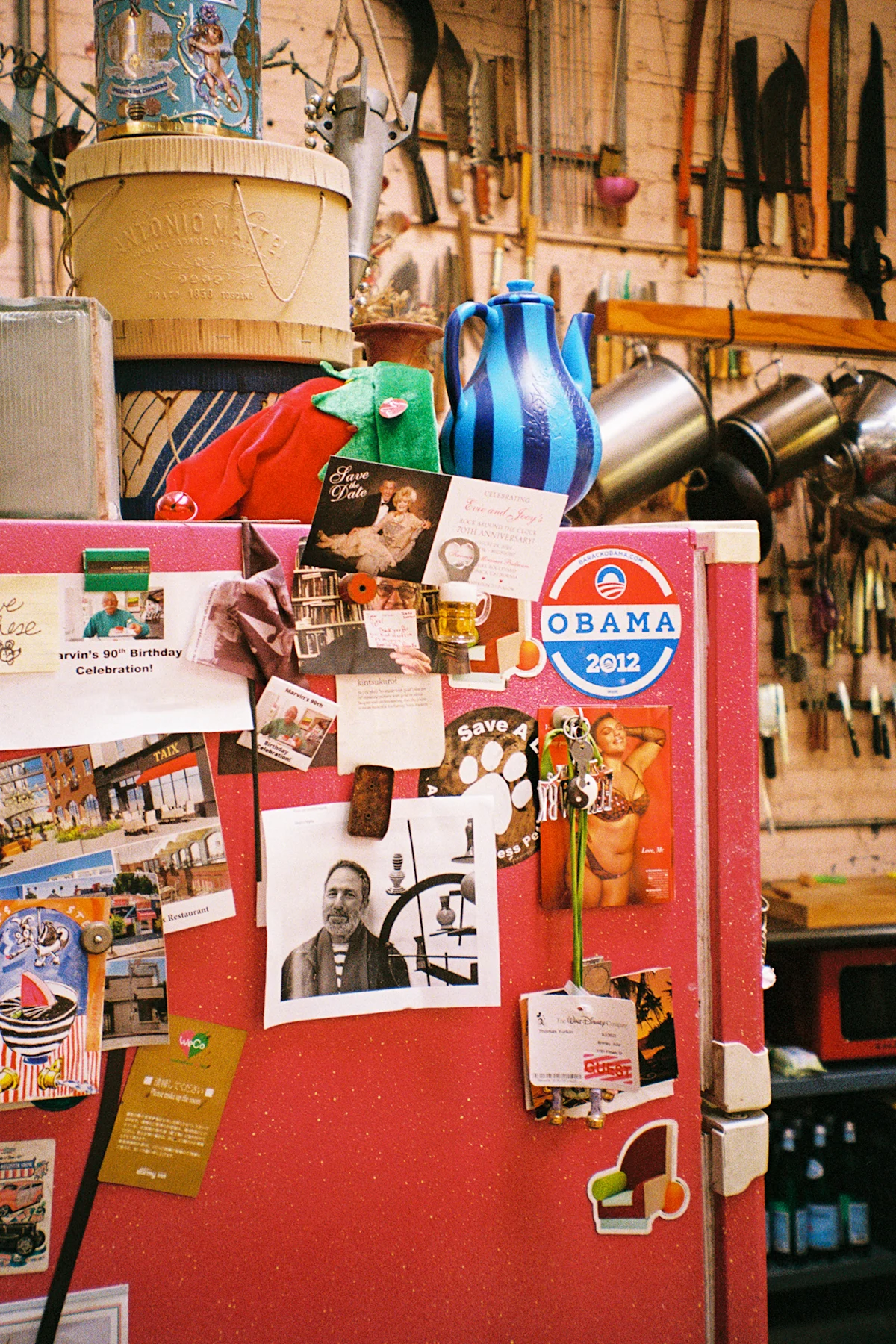To start, can you tell us about your journey into the world of design and art? What initially drew you to this field, and how did your career begin?
⎯⎯⎯ Do you want the short version or the long version
The medium version!
⎯⎯⎯ Put it on a bumper sticker! Haha well, my parents, my home.
The same home that you live in today?
⎯⎯⎯ Yes, in Echo Park. It was designed by Josef Van der Kar, a modernist and post and beam architect. This house is truly an example of mid-century architecture, and people come to see it, partly because it was a very high-end architectural home, it was not expensive, but it was very pure in design and it was finished in 1950! So really midcentury.
How did that house affect your path to becoming an artist/designer?
⎯⎯⎯ In this house, Josef had created a section that was made up of five doors, a sort of corner that would allow you to transform the house into a number of different configurations depending on which doors were open. I think that always engendered this kind of neurosis of making decisions. For instance, when I make a teapot I usually make half a dozen—actually, I like odd numbers so I will make 3, 5, or 7 —that’s because I can’t decide what colors to paint them so I have to try each one. I always think it can be done this way or that way! You don’t know until you see it.

That is an interesting approach to decision making. There are so many nuanced ways artists navigate the endless choices in creating work
⎯⎯⎯ I was re-reading Francoise Gilot’s book “Life with Picasso”, a part that struck me recently she describes how Pablo was looking at a painting of his and he wanted to try it in a different color, so he asked Francoise to chalk out the outline on a canvas for him to paint the new colors the following day. She explains that just that year she did about 8 paintings that way.
So even Picasso would try out different configurations of colors
⎯⎯⎯ Yes, this gets us to the great saying “What is the difference between painting and drawing? Drawing is when you make the little lines and painting is when you fill them in!” I told that to the gallerist Jeffrey Deitch, and I didn’t have the third one which is “What is sculpture?” We joked “Sculpture is what you bump into when you look at a painting!” Here is my first joke.
Your work often blurs the line between art and design. Can you share your approach when it comes to this intersection of disciplines?
⎯⎯⎯ Well to continue on the previous joke, but instead: what is the difference between art and design? To understand the difference between art and design, it's really all about how our language and society have evolved. Take Michelangelo's work on the Sistine Chapel, for example. When he presented his plans to the Pope, they were called 'cartoons', a term that means something entirely different today. This shift in language mirrors how our understanding of art and design has changed. Similarly, when we talk about design now, it's not just a career or an entity; it's reflective of a major societal shift from a world of individual craftsmen to an industrial society. Sherwood Anderson captures this beautifully in "Winesburg, Ohio." He tells a story about the town's best harness maker who, despite his craftsmanship, starts buying cheaper, mass-produced harnesses from Chicago. This change marks a turning point in how we view objects and what we call design. It's no longer just about handmade items; it's about the things that enhance our life and how they're created. So, in this new era, designers are like the modern version of craftsmen. They're not making things with their hands; rather, they're directing machines to do it. It's a fascinating evolution, where the role of creating has shifted from manual labor to a blend of creativity and technology.

Have you ever considered yourself a designer?
⎯⎯⎯ At times, but within that kind of matrix of definition, I clearly don’t have the ability to communicate with a group of fabricators on that level. If I try to do that they know I don’t belong, so I gotta make this weird shit.
As weird as it gets you do still create tables, armchairs, teapots… typical design items which are also currently on display in an art gallery.
⎯⎯⎯ Yes, and many of them are about addressing symbols and metaphors and not about addressing comfort, ease of maintenance, or practicality, as a designer would aim to do. I came out of pottery, and I thought I would be a potter.
And how did your path take you here?
⎯⎯⎯ It had a lot to do with the moment I was coming of age in Southern California, in school there was a group of older guys and they were forging actual full-time careers as studio artists so it became clear that this was something I could do. Before that, there was a group of potters in the 1950s that had more of a bohemian lifestyle, and that to me seemed not as viable and probably not very exciting once you get into it. There is not much of a challenge there.
The ones who opened my eyes were Peter Voulkos, John Mason, Paul Soldner, and Ken Price. They had come in and really shifted the emphasis of clay into the sculptural medium, and not just a tool for creating bronze models. And that was really starting to get a lot of attention and our whole department was going that way.
There was also Adrian Sacks who had his own studio and had come back to school and was amazing and really interjected all kinds of stuff and ways to think about things. We would work together, and he was one of the few who could work and talk, we would go to his studio together and he’d talk and I’d listen and at one point he said: You know you can make a teapot that pours out of the bottom… I thought “Woah now we are talking!” One of the keys is the ideals of absurdity and pushing ridiculousness to a new high
The teapots you make today are pushing the boundaries
⎯⎯⎯ We made some called the Echo Park Pottery Teapot, it was simply an orb with a spout and a non-typical loop handle. The proportions were very odd, and it was as close as I got to a production item here.
So it was still handmade by hand here in the studio
⎯⎯⎯ Yes. And I’ve seen how pottery can become kind of like an engine, a drive in a machine, a real potter produces a lot of work.

What is a measure of that, in your opinion?
⎯⎯⎯ A great metric is those little factories like in Deruta and Vietri sul Mare, and overseas in Asia too, there can be just a couple of potters and then about twenty-five workers decorating the pieces as they come out. You need that many just to keep up with the speed of the potters.
Have you ever done work in a pottery production as such?
⎯⎯⎯ Yes in Deruta Perugia, in the early 2000’s. I worked there to create a series, and at that particular factory, there was a group of women doing the paintwork of the pieces, which I worked with very closely. The potters produced the shapes, and those women would come in, glaze the pieces, then paint the designs on them. Glaze is essentially powder with water, and the trick —which I only learned after—was to paint the decoration while the glaze still had moisture… not knowing this, I had all of my 50 pieces glazed ahead of time. At that moment, all the painter women raised their eyebrows like I was crazy! But every day, I would go in, and I painted all darn fifty of them carefully even though the glaze dried out.
Afterward, I made a painting plate of a self-portrait, and I wrote on it, “ I love all the women in the painting room, and they love me!” To hang in the studio as a fun reminder
Living in Los Angeles has had a profound impact on many artists and designers. How has the city influenced your work and creative vision over the years?
⎯⎯⎯ I had never really considered that until recently, I ran into an old classmate from the 5th grade, she described to me how she grew up in Chinatown LA, in her confined and pressured Asian community. Afterward, she had moved to Echo Park and she didn't know how to act in this new neighborhood, it was completely different. I started to think about it, as I grew up in Echo Park, at that time when I was young, Los Angeles was not so built up, and especially the way my parents were, my brother and I were relatively unsupervised. My brother and I would be free to run around the open lots and if we wanted to go up the hill we would simply go up the hill, we didn't organize play dates or ask permission to adults. And so that freedom explains a lot of my behavior of being self-possessed, making decisions without reference and without restrictions.
That sense of liberty and exploration absolutely comes through in your work
⎯⎯⎯ Certainly, freedom finds its way into my work, and those influences are going to be the same for people growing up now. Growing up in Echo Park has injected its way into my work.

So what is the significance of the “Rumpus Room” in terms of the exhibition and that selection of work?
⎯⎯⎯ Well after I titled the show I was reading the book and this excerpt summarised what I was thinking perfectly: It has rained all day. Not that I mind rain, but this is the day I promised to put up the screens and take my kid to the beach. I also meant to daub some giddy stencils on the composition walls of the place in the cellar which the realtor called a Rumpus Room and to start finishing what the realtor called an Unfinished Attic, Ideal for Guest Room, Game Room, Studio, or Den.
Somehow I got sidetracked right after breakfast. This passage nails down that mundane, real estate jardon... An ideal. And the rumpus room is the one room in the house where things can go wrong. And that is my definition of the show. It’s not quite chaos but a lot is going on in there… to have in an art gallery, a car, a colorful scooter, weather veins, a doll house, boats, and teapots! It is rumpus! Jeffrey the gallerist wanted it to be an amalgamation of my studio and the studio for me is an “environment” if you will. Most people think of a studio as a super precious laboratory and so when they see mine they say “You should get a real job”.
Your studio is great, it’s in use, it's colorful, and it's lived in
⎯⎯⎯ It can’t be too precious so this is the dilemma of modernism, everything is sterile. Why would you want your environment to be like the space station?
Exactly, everything is hidden in a compartment with no trace of human life
Because there isn't any!
Finally, if you had to describe your work and your creative journey in a few words or a motto, what would that be?
⎯⎯⎯ Well, I've got a couple of them. Sort of the standard one is a Robert Frost quote “Forgive, O Lord, my little jokes on Thee. And I’ll forgive Thy great big one on me” We look for ways to describe the work that is brief and maybe a little enigmatic. Another great one is by Ron Nagle “Cheese now” and also Rabbi Hillel, “If not now, when?”

How do you find these reflect yourself?
⎯⎯⎯ Well, Little Richard said it in a different way, he was talking about a friend of mine Roger who was interviewing him and he kinda looked at him and said “Who is this?” and Roger says “Well.. I’m Roger” and so he says “People, this is ROGER!” He was giving the greatest interview ever, and he said “Get him now, get him while he’s alive!” and that’s what we are talking about. We are set up here, we could have 3-5 people working, Donna and I going along…Come here I am going to show you something. [Peter proceeds to the archive rooms to open drawers and drawers of drawings of project ideas.] These are all design packages of things I have never done and are perfectly doable. Hundreds of drawings I would go crazy if I started digging through and try to pick. What are we waiting for? Again, I go through that neurotic concept of “Is this the one I should make??”
– East Room is a shared workspace company providing design-forward office solutions, authentic programming and a diverse community to established companies and enterprising freelancers. We explore art, design, music, and entrepreneurship. Visit our news & stories page to read more.